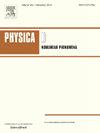物理计算系统的代数设计
IF 2.7
3区 数学
Q1 MATHEMATICS, APPLIED
引用次数: 0
摘要
最近,利用物理系统(物理计算系统)的计算技术得到了发展。要利用物理计算系统,其设计策略非常重要。虽然有基于学习的实用方法和理论方法,但还没有一种通用方法能为特定系统提供具有严格理论支持的具体设计指南。在本文中,我们提出了一种新颖的物理计算系统代数设计框架,该框架能够提取具体的设计指南。我们的方法以代数方式描述输入输出关系,并将其与给定的目标任务联系起来。本文提出了两个定理。第一个定理提供了代数设计的基本策略。第二个定理探讨了此类系统的 "可替代性"。本文通过实验研究了这些系统可能的实现方法。其中包括设计一个系统的输入以生成多个目标时间序列,以及用一个代数设计的给定系统替换静态或非静态目标系统。实验表明,所提出的框架有可能设计出具有理论支持的给定物理计算系统。本文章由计算机程序翻译,如有差异,请以英文原文为准。
Algebraic design of physical computing system
Recently, computational techniques that employ physical systems (physical computing systems) have been developed. To utilize physical computing systems, their design strategy is important. Although there are practical learning-based methods and theoretical approaches, no general method exists that provides specific design guidelines for given systems with rigorous theoretical support. In this paper, we propose a novel algebraic design framework for a physical computing system, which is capable of extracting specific design guidelines. Our approach describes input–output relationships algebraically and relates them to given target tasks. Two theorems are presented in this paper. The first theorem offers a basic strategy for algebraic design. The second theorem explores the “replaceability” of such systems. Their possible implementations are investigated through experiments. In particular, the design of inputs of a system so that it generates multiple target time-series and the replacement of stationary or non-stationary target systems by a given system that is designed algebraically are included. The proposed framework is shown to have the potential of designing given physical computing systems with theoretical support.
求助全文
通过发布文献求助,成功后即可免费获取论文全文。
去求助
来源期刊

Physica D: Nonlinear Phenomena
物理-物理:数学物理
CiteScore
7.30
自引率
7.50%
发文量
213
审稿时长
65 days
期刊介绍:
Physica D (Nonlinear Phenomena) publishes research and review articles reporting on experimental and theoretical works, techniques and ideas that advance the understanding of nonlinear phenomena. Topics encompass wave motion in physical, chemical and biological systems; physical or biological phenomena governed by nonlinear field equations, including hydrodynamics and turbulence; pattern formation and cooperative phenomena; instability, bifurcations, chaos, and space-time disorder; integrable/Hamiltonian systems; asymptotic analysis and, more generally, mathematical methods for nonlinear systems.
 求助内容:
求助内容: 应助结果提醒方式:
应助结果提醒方式:


